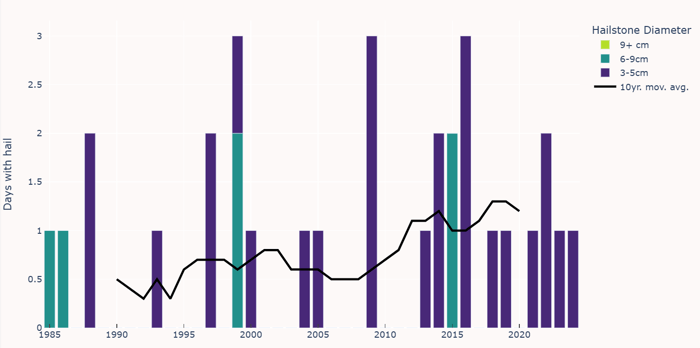Hailstorms have long been one of Australia's most damaging weather events, causing billions in insured losses and impacting industries from agriculture to infrastructure. However, new research suggests a significant shift in where hailstorms occur, presenting new challenges for forecasting and risk management.
 Image of hail damage during a storm in Ipswich - taken by EWN's James Chambers
Image of hail damage during a storm in Ipswich - taken by EWN's James Chambers
Studies have observed a southward shift in hailstorm occurrences. Research led by Dr. Tim Raupach at UNSW Sydney found that the annual number of hail-prone days has increased by up to 40% around Sydney and Perth over the past four decades while decreasing in other parts of Australia. This shift is attributed to changes in atmospheric instability, a key factor in hail formation.
Similarly, the Bureau of Meteorology's research scientist, Dr. Joshua Soderholm, highlighted that regions like Sydney and Canberra are experiencing more hailstorm days, whereas traditionally hail-prone areas such as Brisbane are seeing a decline. This trend aligns with the broader pattern of climate-driven atmospheric changes influencing hailstorm distribution.

This map shows the changes in annual hail-prone days per decade. The black dots ("stippling") show where
the trend was considered statistically significant. Credit: University of New South Wales
Hailstones form under specific atmospheric conditions, particularly within supercell thunderstorms characterised by strong updrafts that allow hailstones to grow larger before descending. The variability in hailstone size and frequency is influenced by factors such as atmospheric instability and wind shear. As these conditions evolve due to climate change, regions previously less affected by hailstorms may now face increased risks.
In response to these shifting patterns, Climatics offers advanced tools to monitor and analyse hailstorm trends across Australia's eastern states. By leveraging historical data and real-time analytics, Climatics provides valuable insights into hailstorm frequency, intensity, and distribution.
Key capabilities of Climatics include:
- Historical Data Analysis: Utilising decades of weather data to identify trends and shifts in hailstorm activity, aiding in long-term planning and infrastructure development.
- Hail Event Mapping: Displaying past hailstorm tracks to help businesses assess areas most frequently impacted and understand how risk is evolving.
- Risk Assessment Tools: Assessing potential hailstorm impacts on specific locations, supporting industries such as agriculture, insurance, and construction in developing targeted mitigation strategies.
Climatics’ analysis of hailstorm data highlights some notable trends:

Brisbane is seeing an increase in 3-5cm hail events, but a shift away from larger 6-9cm events. Historically, the city experienced 6.5 events per decade, whereas the present frequency has risen to 9.4 events per decade. The peak month for hail events in Brisbane is November.


Canberra (above 2 images) has seen the most significant increase in hailstorm activity. Historically, Canberra experienced only 0.5 events per decade, but the present frequency has surged to 5.2 events per decade, with the the number of hail-prone days also increasing. The peak month for hail events in Canberra is January.

Parramatta (above) is seeing a trend in the amount of hail-prone days as well, with a clear increase in the number of days forecast to receive giant hail.
By integrating Climatics' platform into their operations, businesses and communities can enhance their preparedness and resilience against the evolving threat of hailstorms.
Adapting to the New Hailstorm Landscape
The southward shift in hailstorm activity shows the importance of adaptive strategies in risk assessment and infrastructure planning. Stakeholders must consider these changing patterns to implement effective measures that mitigate the impact of hailstorms. Leveraging platforms like Climatics ensures access to accurate data and predictive analytics, which is essential for informed decision-making in the face of climate variability.
As climate change continues to influence weather patterns, staying informed and prepared is crucial. Understanding the dynamics of hailstorm distribution and utilising advanced monitoring tools will be key in safeguarding communities and assets from hail-related damages.